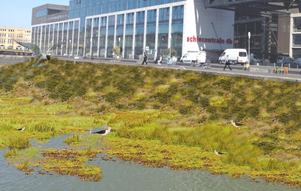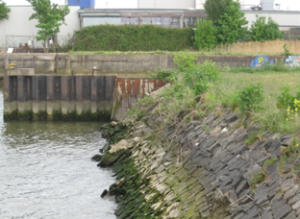Overview
Location: Beneden Merwede Dordrecht, Nieuwe Maas Rotterdam
Date: 2014-present
Involved parties: Municipality of Dordrecht, Municipality of Rotterdam, Deltares, Witteveen+Bos
Technology Readiness Level: 6 – technology demonstrated in relevant environment
Environment: Rivers & Estuaries, Cities, Ports
Keywords: Natural embankments, tidal park, city, water framework directive, BwN in the City

Green bank systems partly restore the lost tidal ecosystem that once was so abundant and unique for the area. The Building with Nature interventions do not only provide educational and ecological value, but also add value in the sense of a more attractive and healthier living environment within the borders of a city.

Traditional bank systems are strengthened with hard material (mostly rock) prohibiting vegetation growth. Vegetation is often regarded as a stability risk and may also be aesthetically undesired. Urban parks along river banks are separated from the river by obstacles of hard material to meet safety criteria for citizens.
In the project Building with Nature in delta cities, small areas of tidal nature are created in heavily urbanized areas in Dordrecht and Rotterdam to mitigate the impact of human building activities on the tidal ecosystem and to create beneficial societal goals.
Project objective
Delta cities are situated along rivers with tidal hydrodynamics. Large parts of the tidal ecosystems disappear as a result of urbanization, realisation of industry and water safety measures. Three different pilots investigated how to implement Building with Nature in such an urbanized tidal environment. The aim of the pilots is:
- to mitigate the impact of human building activities on the tidal ecosystem;
- to create beneficial societal goals.
Pilots
Wervenpark Dordrecht (Shipyard park)
Stadswerven is a new-build development where the municipality is creating a waterfront park, the Wervenpark, next to housing areas in the abandoned slipway of an old shipyard. Various solutions for gradual transitions between land and water were identified which enable the water to flow into the park when the tide rises. This leads to the return of tidal flooding, which is characteristic of this area. Moreover, it increases the attractiveness of the area. The hard embankment has been replaced by a nature-friendly shore that moves and develops with the dynamics of the Beneden-Merwede river stretch.
Mallegatpark Rotterdam (park Mallegat) and Nassauhaven Rotterdam (Nassau harbour)
Knowledge gained in the Dordrecht pilot was used to design natural, tidal bank systems along the urbanized parts of the Nieuwe Maas river in Rotterdam. The designed bank systems will contribute to the goals of the European Water Framework Directive and to the ambitions of the Municipality of Rotterdam to improve quality of life along the Nieuwe Maas river (liveability and recreation) (Gemeente Rotterdam, 2018).
Costs and benefits
The restoration of tidal ecosystems potentially leads to cost reduction, for instance by reducing the need for hard coastal defence structures, and to additional benefits including:
- increasing the value of the area;
- creation of small habitats or stepping stones for tidal fresh water and brackish water species;
- three unique parks/embankments for people to recreate;
- three unique parks/embankments with educational value regarding tidal ecosystems raising citizens awareness;
- contribution to European Water Framework Directive targets;
- possibly (needs to be proven in coming years) an increase of real estate values;
- increased CO2-uptake and sedimentation of particulate matter.
